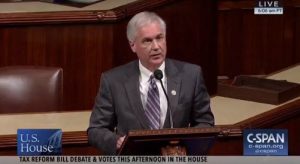McClintock: To Preserve, Protect And Defend
Earlier this week, Congressman Tom McClintock took to the US House Floor to voice his opposition to override President Trump’s veto of a declared national emergency regarding the US Mexican border.
Here are the words of Congressman McClintock.
“Mr. Speaker:
For 43 years, the President of the United States has had the statutory authority granted by Congress to declare a national emergency and to re-program unobligated military construction funds to meet that emergency. Fifty-eight times, previous presidents have invoked this authority to address such matters as civil unrest in Sierra Leone and Burma.
Only when THIS President invoked his authority for the 59th time to address the most serious national security risk our country has faced in our lifetimes – the collapse of our southern border – do we hear protests from the left and its fellow travelers.
Under our Constitution, the Congress appropriates money but cannot spend it and the President spends money but cannot appropriate it. He spends it according to laws given him by Congress. In this case, Congress appropriated funds, and delegated to the President precisely the authority to spend those funds that he is now exercising. Whether Congress should have delegated this authority is a separate question that no one has raised in 43 years. But while that authority exists, the President has both a right and a duty to use it to defend our country.
We also hear protests that the President’s act will divert money from other military projects. Listen to what these people are saying: they care more about defending the Iraqi border than defending our own. Such people should not be entrusted with the defense of our country.
I stand with the President who is acting within our Constitution to preserve, protect and defend it, and against the radical left in this house that would dissolve our borders entirely if given the chance.
History warns us that nations that cannot or will not defend their borders aren’t around very long. Let that not be the epitaph of the American republic or the Constitution that created it.”
After a 19-year drought, the seven Colorado River Basin states (including California) have come together to address water shortages with the new Colorado River Drought Contingency Plan. The Subcommittee on Water, Oceans and Wildlife heard from these states on Thursday as they presented the plan and explained how water will be shared.
An opening statement was given by House Natural Resources Committee Ranking Member Tom McClintock who is on the Subcommittee on Water, Oceans and Wildlife. Here are his words:
“The Subcommittee meets today to consider the Colorado Drought Contingency Plan, agreed to by all of the states that draw from the Colorado River Basin.
The dams on the Colorado have been the foundation of the prosperity of the Western states that rely on them to store water from wet years to assure abundance in dry ones. Forty million people and 5 ½ million acres of productive farmland now depend on the water stored behind these dams and 4,000 megawatts of hydroelectricity their turbines generate.
Both natural and man-made developments have brought us to this juncture.
The first is the continuing drought in the American Southwest. Precipitation in most of the continental United States has increased considerably since the turn of the last century — almost 2/10ths of an inch per decade. The exception is the Southwest, which has seen a decrease in precipitation in the same period as weather patterns have shifted.
In addition, the original allocations of Colorado River water were set back in 1922, during a period of unusually high precipitation, thus building into the system an overestimate of available system-wide supply.
As Yogi Berra famously observed, “It’s tough to make predictions, especially about the future.” The good news is that the Upper Colorado Snowpack is currently 128 percent of normal for the year. February precipitation was well above the 30-year median, double in most places, and this month is likely the be the wettest March on record in the Colorado Basin.
But one good year is no guarantee the 19-year drought is over, and prudence and experience both warn us of the need to be prepared. Droughts have plagued this region from time immemorial – over the last 1,200 years there have been five periods with droughts equal or greater than this one. Indeed, in the mid-1100s, the region experienced a 25-year drought. History is desperately warning us to be prepared.
And one thing is absolutely certain about the future of the Colorado River Basin: demand for water will continue to increase with population, while the supply of water will continue to fluctuate. That is the fine point of the matter and an inescapable reality we cannot ignore.
It is a remarkable development that seven of the most politically diverse states in the nation could find agreement on something as controversial as reduced water allocations, but that miracle is before us today. I think we would be well-advised to show a little humility and defer to the judgment of the states that directly depend on the water allocations set forth in this contingency plan.
During the miracle at Philadelphia, Benjamin Franklin observed that the principle difference between the Catholic and Protestant religions was that the Catholics believed their church is infallible while the Protestants believed that their church is never wrong. His advice to them that day – which I believe is entirely applicable here – is that we should each doubt a little of our own infallibility and in this case, approve this compact.”
The “Newsmaker of the Day” is heard every weekday morning at 6:45, 7:45 and 8:45 on AM 1450 and FM 102.7 KVML.

